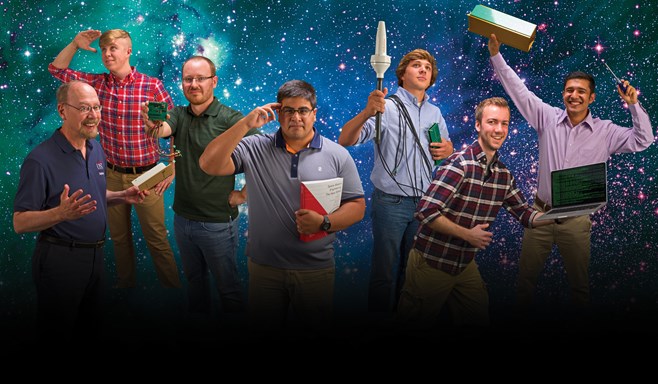Alumni Resources
About the University
By Ben Luttrull

Sometimes, it’s possible to see that a team works well together just by watching them interact; the insider jokes and the way they finish each other’s thoughts even when discussing subjects outside of their expertise, are tell-tale signs of a high-functioning team. A team of USI undergraduates possesses those qualities and more. And they need them if they hope to pull off their mission—to build a satellite to NASA (National Aeronautics and Space Administration) standards and command the unit while downloading data as it travels around Earth for 400-plus days.
In August 2016, Dr. Glen Kissel, associate professor of engineering, received a NASA grant to build and deploy the Undergraduate Nano Ionospheric Temperature Explorer (UNITE), a CubeSat (miniaturized satellite) designed to explore the lower ionosphere and measure plasma and temperature levels before tracking the satellite’s orbital decay as it returns to Earth. USI’s elite team is one of 23 across the nation building CubeSats, and one of 47 student groups working on NASA projects. “Usually, projects like these are taken on with graduate students and full-time research faculty,” said Kissel, “not undergraduates.”

To build the satellite, Kissel needed a team of students who had both the necessary skills and “clearly wanted to be part of a space-orientated project.” Jose Fregozo ’17, Wyatt Helms ’19, Ryan Loehrlein ’19, Haley McConnell ’17, Kegan Miller ’17, Bryan Mitchell ’18, Colin Runnion ’18, John Siepierski ’17, Jonah Quirk ’20 and Adam Will ’17 heard the call and came running. “It’s kind of a lofty goal,” said Will, majoring in electrical engineering, “to say we're going to build a satellite and put it in orbit and it will work perfectly.”
“I wanted my hands everywhere, so if someone came up to talk to me about it, I could explain. We all had to work together to make one cohesive device by the end. ” Ryan Loehrlein
That lofty goal came with a steep learning curve and a feeling of “shell shock,” according to Helms, communications lead, as each team member was confronted with the amount of information they had to process to meet NASA’s 18-month deadline. Fregozo, who’s in charge of the drag subsystem, said he was handed 50 academic papers and told, “Learn as much as you can, because our first review is in November.”
NASA projects come with NASA reviews: four mandatory check-ins with NASA personnel, three via videoconference and one in person in Wallops Island, Virginia, a process both fondly remembered and cursed by the team members as the “mutual suffering” which brought them together. “Being faced with experts really exposed the team to what they needed to work on,” said Fregozo, “but also showed how the team could help each other out.”
The original team Kissel created for the UNITE project revolves around NASA’s timelines, which means team members transition in and out at the end of each semester.
When Siepierski, the initial team leader, graduated last year, Kissel tapped Will to take on the mantle of leadership, and Zack Snyder ’19, who programs software, along with Sujan Kaphle ’19, the team’s new mechanical lead, were recruited to the team. After a brief period of “drinking from a firehose,” they were quickly integrated into the team. “We were [in their shoes] a year ago, and we know the learning curve,” said Loehrlein, who had his firehose moment while managing the GPS subsystem.
USI’s UNITE satellite is on track for an early delivery in January 2018, and their NASA mentors laud the team’s progress in each review, compliments the maturing scientists take pride in, knowing they’ve left strong impressions on the engineers and project managers who do this for a living.
Kissel downplays his role in the project’s success, something the team is quick to counter. Instead, he focuses on the collective work of the team and their responses to the challenges. “These students didn’t know each other prior to the project, and they’ve come together quite well. I’m happy to see that.” It’s a closeness forged by hard work and a shared respect for the task at hand. “We all know what’s at stake,” said Will. “It’s nice that everyone is self-motivated to see the satellite succeed.”
To date, the team has planned, designed, simulated, programmed and started construction of the UNITE CubeSat, but once NASA provides a rocket for their satellite to be launched from, the “real project” will come to life. After the launch, the team will transition to commanding the satellite and downloading data from the sensors, as well as face a transition in team members when team leader Will graduates, which is around the time they hand the satellite off to NASA.
The loss of a leader is daunting, said Loehrlein, who described “horror stories” he’s heard about teams failing after they move from building to commanding, “so we have to make sure that doesn’t happen to us,” he said. “It’s going to be crucial to the mission, as we bring in more individuals, that we get them adjusted to how we work. At the beginning of last year, I couldn't tell you anything about the other team members. Now, these are people I know I can call any day and ask questions, and not even about CubeSat.”
Looking at this team—a tight-knit group of students who’ve worked side-by-side for over a year and still have a long way to go before their success becomes official—one thing is clear; like any good NASA team, they’re a family.
If you enjoyed this story, let us know at magazine@usi.edu.